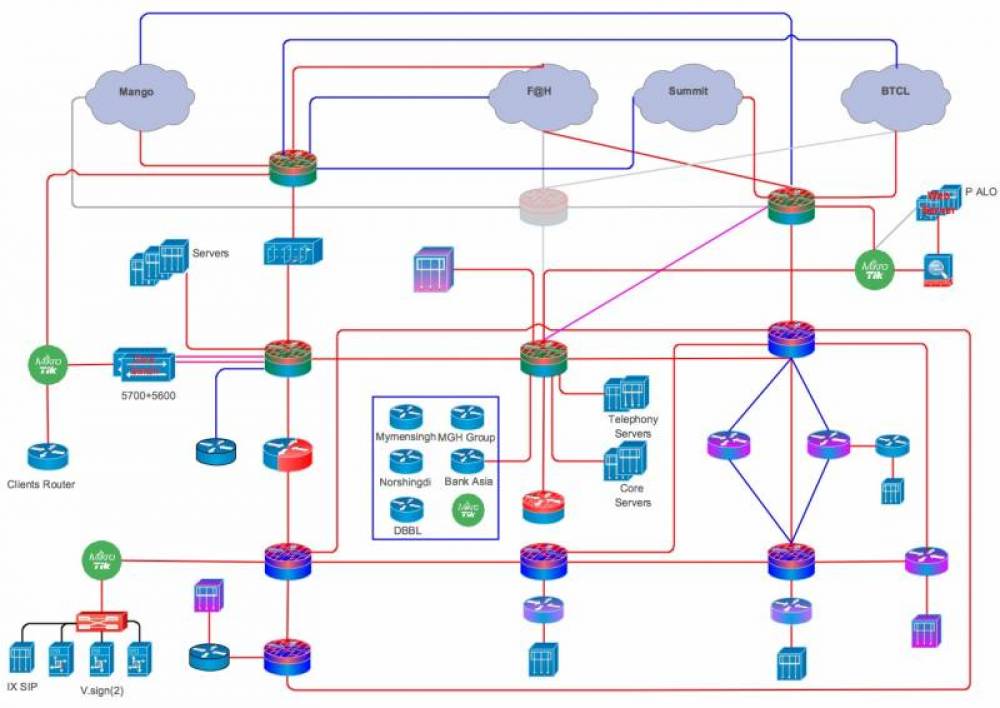Table of Contents
Nationwide ISP network example:
BGP Route Reflector RR Reduced number of BGP peering sessions (RFC 4456)
In BGP (Border Gateway Protocol), RR stands for Route Reflector. A Route Reflector is a mechanism used in BGP to reduce the number of peering sessions required in a network that has a hierarchical structure, such as a service provider network. In such networks, there may be many BGP routers that are not directly connected to each other, but rather are connected through intermediate routers.
A Route Reflector is a specialized BGP router that acts as a central point of reflection for BGP updates. Instead of requiring every BGP router to establish peering sessions with every other BGP router in the network, each BGP router only needs to establish peering sessions with one or more Route Reflectors. The Route Reflector then reflects BGP updates it receives from its peers to all other peers, allowing them to learn about the same set of routes.
The benefits of using Route Reflectors in BGP include:
Reduced number of BGP peering sessions: By using Route Reflectors, the number of BGP peering sessions required in a hierarchical network can be greatly reduced, which can simplify the network configuration and reduce operational overhead.
Improved scalability: Route Reflectors can improve the scalability of BGP by reducing the amount of processing required on each BGP router and reducing the number of BGP update messages that need to be transmitted across the network.
Better control over routing policies: Route Reflectors can provide better control over routing policies in a hierarchical network by allowing administrators to define different policies for different levels of the hierarchy.
However, Route Reflectors can also introduce some potential issues, such as the possibility of creating routing loops if not configured properly. It is important to configure Route Reflectors carefully and follow best practices to ensure a stable and efficient network.
Category ISP Network example:
PPPoE (Point-to-Point Protocol over Ethernet) and RADIUS (Remote Authentication Dial-In User Service) AAA (Authentication, Authorization, and Accounting) are two separate but related technologies commonly used in networking and internet service provider (ISP) environments.
PPPoE is a protocol used to establish a network connection over Ethernet. It is commonly used by ISPs to provide internet access to their customers. PPPoE works by encapsulating PPP (Point-to-Point Protocol) frames within Ethernet frames, allowing for the transmission of data over an Ethernet connection. PPPoE requires authentication to establish a connection, typically using a username and password provided by the ISP.
RADIUS AAA is a system for centralizing authentication, authorization, and accounting functions. It is commonly used in enterprise and ISP environments to manage network access and enforce security policies. RADIUS servers are responsible for authenticating users, authorizing their access to network resources, and tracking usage for billing and auditing purposes. RADIUS authentication can be used with a variety of protocols, including PPPoE.
In the context of ISP environments, PPPoE and RADIUS AAA are often used together. The ISP will use PPPoE to establish a connection with the customer's equipment, and then use RADIUS AAA to authenticate the customer and authorize their access to the internet. RADIUS accounting can also be used to track the customer's internet usage for billing purposes.
Overall, PPPoE and RADIUS AAA are important technologies for managing network access and enforcing security policies in enterprise and ISP environments
TTL and MTU are two important concepts related to network communication.
TTL (Time To Live) is a field in the IP header of packets that specifies the maximum number of hops a packet can take before it is discarded. Each time a packet is forwarded by a router, its TTL field is decremented by one. When the TTL field reaches zero, the packet is dropped, and an ICMP message is sent back to the sender indicating that the packet has expired. The purpose of the TTL field is to prevent packets from circulating indefinitely in the network.
MTU (Maximum Transmission Unit) refers to the maximum size of a packet that can be transmitted over a network. The MTU is determined by the underlying network technology and is usually measured in bytes. When a packet is larger than the MTU of a network, it is fragmented into smaller packets that can be transmitted over the network. Fragmentation can add overhead and reduce performance, so it is generally desirable to keep packet sizes within the MTU of the network.
Ping and jitter are both terms used in networking to describe aspects of the performance and quality of a network connection.
Ping refers to the time it takes for a packet of data to travel from one device to another device on the network and back again. It is measured in milliseconds (ms), and a lower ping time generally indicates a faster and more reliable network connection. Ping is often used to test the latency or responsiveness of a network connection.
Jitter, on the other hand, refers to the variation in the delay between packets of data as they travel across a network. It is also measured in milliseconds (ms), and a lower jitter time generally indicates a more stable and consistent network connection. Jitter can cause problems with real-time applications such as VoIP (voice over internet protocol) or video conferencing, as it can result in choppy or distorted audio or video.
ping measures the round-trip time for a packet of data to travel from one device to another and back again, while jitter measures the variation in that delay between packets.


